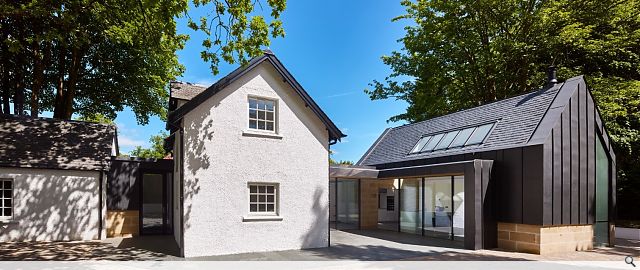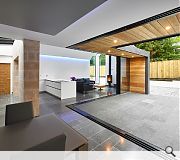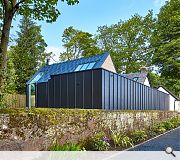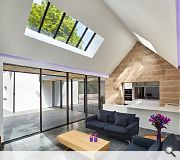Arnothill
The project brief sought to create a new 3 bedroom house with ample utility and storage space, of modest size but high quality design. Additionally, the client stated that good thermal performance and low running costs was essential across the full spectrum of seasonal changes. Finally, there was also a request to explore methods by which the internal living spaces and the external social spaces could be fully connected. Naturally, an open plan layout with good visual and physical links was the most commensurate solution to these requirements. A series of new build connecting elements were designed to provide for this, and more contemporary materials were used to provide a strong contrast while retaining harmony with the existing Stables and Coach House. Use of natural light was paramount throughout, with provision outwith the open plan area for smaller, more intimate spaces to be used for sleep and study.
A series of turning architectural gables take their inspiration from the relationship of the existing buildings and the architectural style of the main villa, situated nearby. The grouping is arranged around a series of courtyards, conceptually defined as ‘entrance, heart and back green’. The entrance courtyard allows the existing buildings to command their own setting, whilst the 'heart' courtyard provides a more discreet social space as the new link element transfers to a single storey volume, finally receding into the 'back green'; a quieter, more contemplative and intimate space
The palette concentrates on the use of high quality materials; ashlar stonework plinth, zinc cladding, aluminium framed glazing, slated roof and courtyard paving.
Conceived as an inside-outside dwelling, this project is arranged around a central courtyard with secondary courtyard spaces toward the front and back of the procession. Large glazed sliding doors flank two sides of the main 'heart' courtyard, allowing the living areas to be fully opened to the outside. A cantilevered canopy projection offers shelter when the weather is adverse, and in combination with the other glazed elements effectively manages sun penetration throughout the year, providing ample light with minimal glare. The living room takes on a contemporary gable form echoing the existing stables and coach house, while both the existing buildings and the new living room volume are connected by a single-storey link, allowing all three pavilions to function as a single dwelling. The existing buildings are small and cellular in nature, and therefore lend themselves naturally to becoming the bedroom and study spaces, providing a cosier and more intimate environment.
Set within the Arnothill and Dollar Park Conservation Area, the design proposal adopts an approach referred to as 'a best practice for building conservation' by the local planning authority. Each of the existing buildings are retained and conserved with a strategy of like-for-like repair implemented, including but not limited to reuse of existing slate, render repairs in traditional wet-dash, replacement matching timber windows and renewal of rainwater goods all in cast iron. The new elements are distinctly modern and of their time, providing a visual contrast which accentuates the conserved elements while not compromising their charm or disguising their original function. Each pavilion is set away from the next to allow each to retain its own setting and complements the courtyard landscape strategy created by the existing buildings. The new elements are constructed as free facade framed structures, a mixture of steel, timber, glass and stone. This allows large volumes and open plan spaces consistent with contemporary living aspirations, whilst the smaller cellular existing buildings lend themselves easily to more intimate spaces such as bedrooms and a study area with little intervention. Taken as a whole, we hope this creates an interesting chronology of evolution across the site, enhancing the richness of its character and retaining the heart of a small but important piece of history.
A series of turning architectural gables take their inspiration from the relationship of the existing buildings and the architectural style of the main villa, situated nearby. The grouping is arranged around a series of courtyards, conceptually defined as ‘entrance, heart and back green’. The entrance courtyard allows the existing buildings to command their own setting, whilst the 'heart' courtyard provides a more discreet social space as the new link element transfers to a single storey volume, finally receding into the 'back green'; a quieter, more contemplative and intimate space
The palette concentrates on the use of high quality materials; ashlar stonework plinth, zinc cladding, aluminium framed glazing, slated roof and courtyard paving.
Conceived as an inside-outside dwelling, this project is arranged around a central courtyard with secondary courtyard spaces toward the front and back of the procession. Large glazed sliding doors flank two sides of the main 'heart' courtyard, allowing the living areas to be fully opened to the outside. A cantilevered canopy projection offers shelter when the weather is adverse, and in combination with the other glazed elements effectively manages sun penetration throughout the year, providing ample light with minimal glare. The living room takes on a contemporary gable form echoing the existing stables and coach house, while both the existing buildings and the new living room volume are connected by a single-storey link, allowing all three pavilions to function as a single dwelling. The existing buildings are small and cellular in nature, and therefore lend themselves naturally to becoming the bedroom and study spaces, providing a cosier and more intimate environment.
Set within the Arnothill and Dollar Park Conservation Area, the design proposal adopts an approach referred to as 'a best practice for building conservation' by the local planning authority. Each of the existing buildings are retained and conserved with a strategy of like-for-like repair implemented, including but not limited to reuse of existing slate, render repairs in traditional wet-dash, replacement matching timber windows and renewal of rainwater goods all in cast iron. The new elements are distinctly modern and of their time, providing a visual contrast which accentuates the conserved elements while not compromising their charm or disguising their original function. Each pavilion is set away from the next to allow each to retain its own setting and complements the courtyard landscape strategy created by the existing buildings. The new elements are constructed as free facade framed structures, a mixture of steel, timber, glass and stone. This allows large volumes and open plan spaces consistent with contemporary living aspirations, whilst the smaller cellular existing buildings lend themselves easily to more intimate spaces such as bedrooms and a study area with little intervention. Taken as a whole, we hope this creates an interesting chronology of evolution across the site, enhancing the richness of its character and retaining the heart of a small but important piece of history.
PROJECT:
Arnothill
LOCATION:
Falkirk
CLIENT:
Private
ARCHITECT:
:thatstudio
STRUCTURAL ENGINEER:
David Narro Associates
Suppliers:
Photographer:
Andrew Lee
Timber Cladding:
Russwood
Glazing:
Gray & Dick
Back to Housing
Browse by Category
Building Archive
- Buildings Archive 2024
- Buildings Archive 2023
- Buildings Archive 2022
- Buildings Archive 2021
- Buildings Archive 2020
- Buildings Archive 2019
- Buildings Archive 2018
- Buildings Archive 2017
- Buildings Archive 2016
- Buildings Archive 2015
- Buildings Archive 2014
- Buildings Archive 2013
- Buildings Archive 2012
- Buildings Archive 2011
- Buildings Archive 2010
- Buildings Archive 2009
- Buildings Archive 2008
- Buildings Archive 2007
- Buildings Archive 2006
Submit
Search
Features & Reports
For more information from the industry visit our Features & Reports section.






